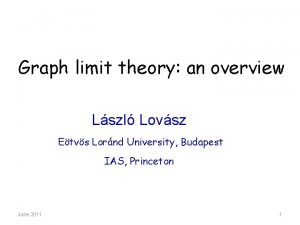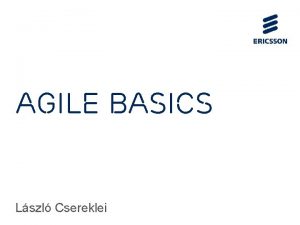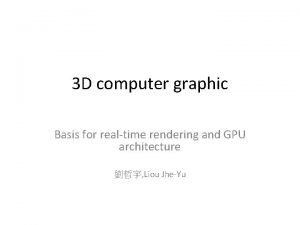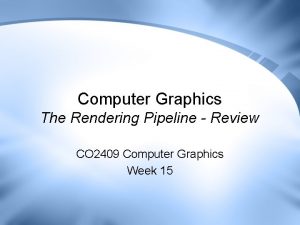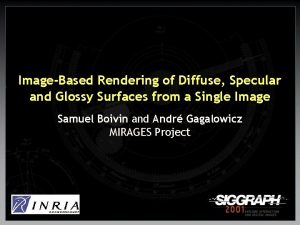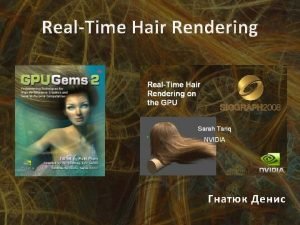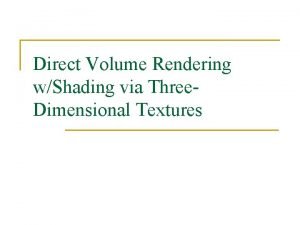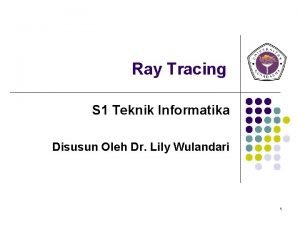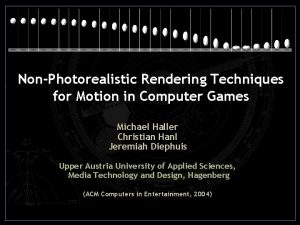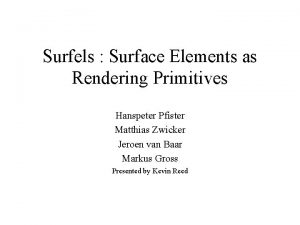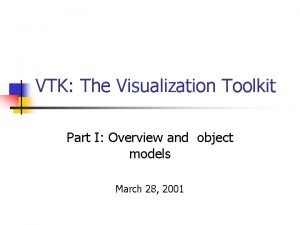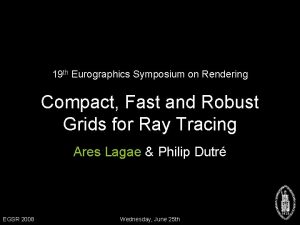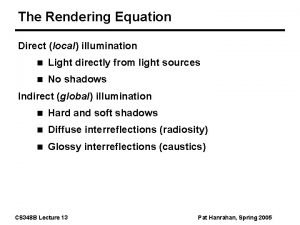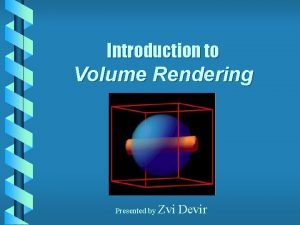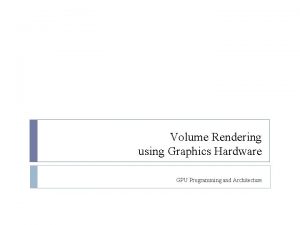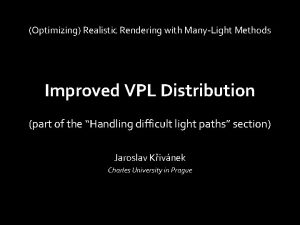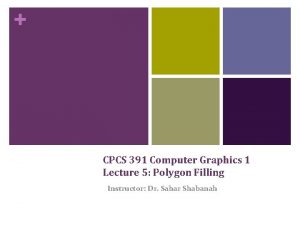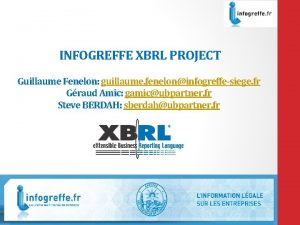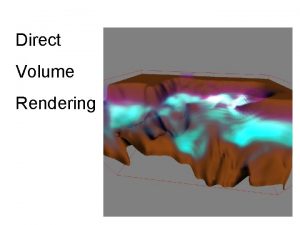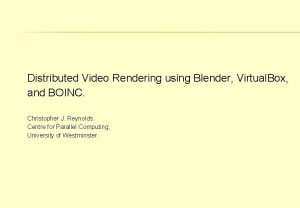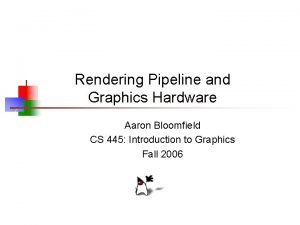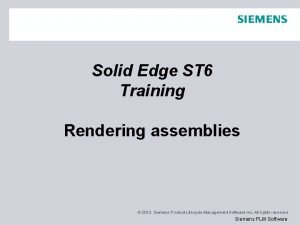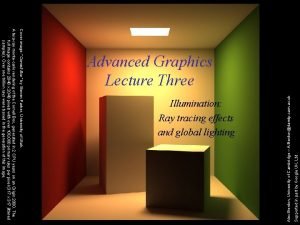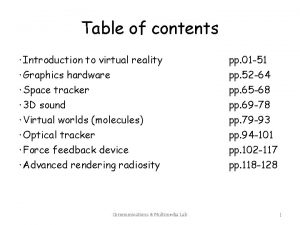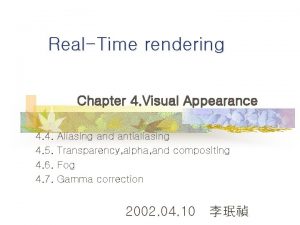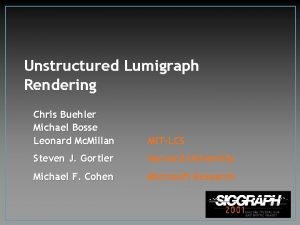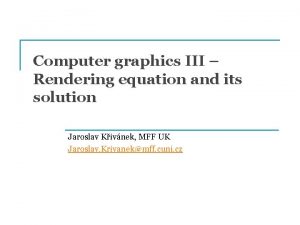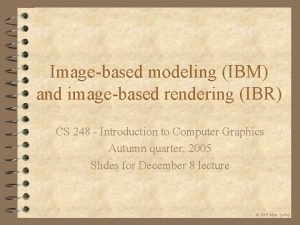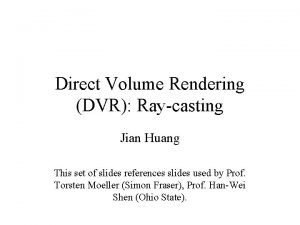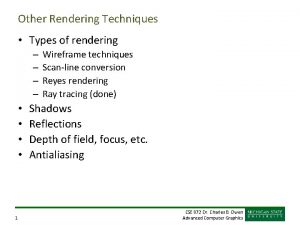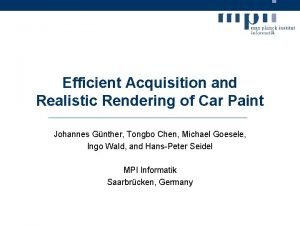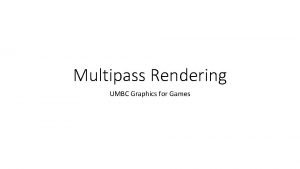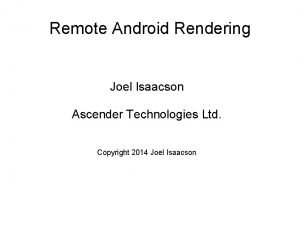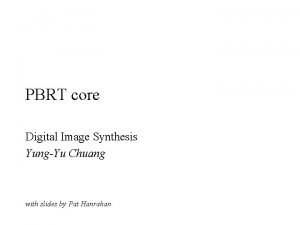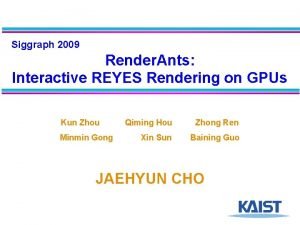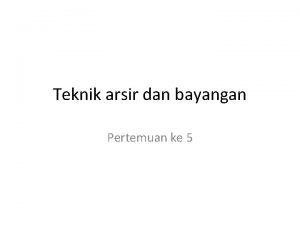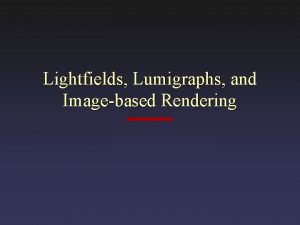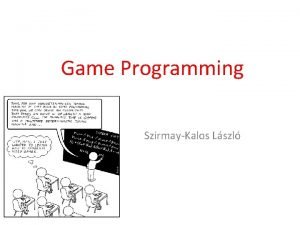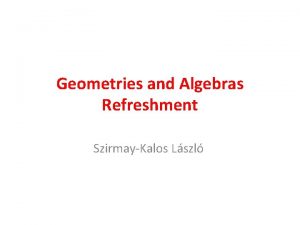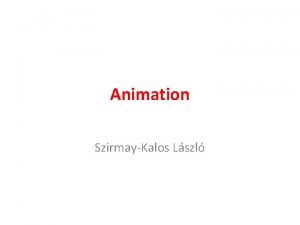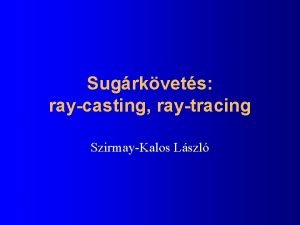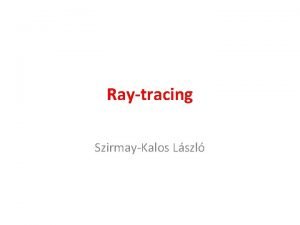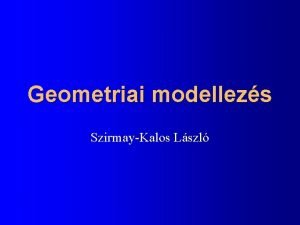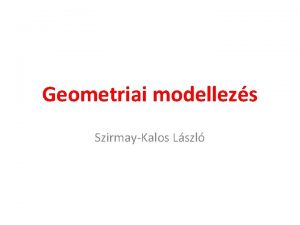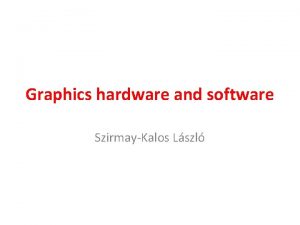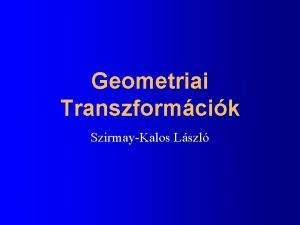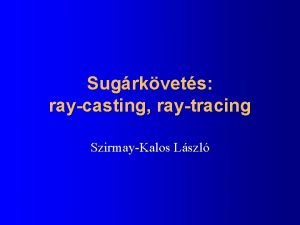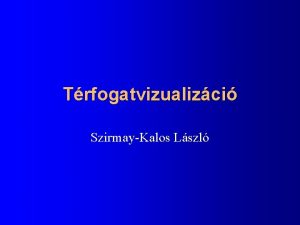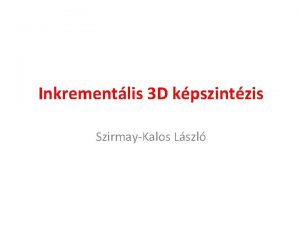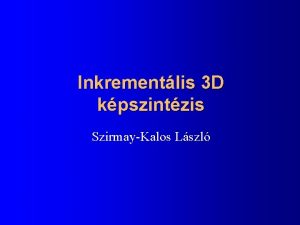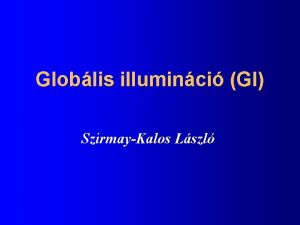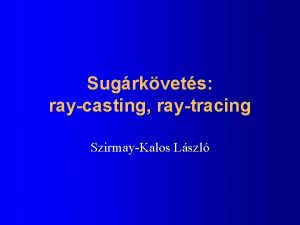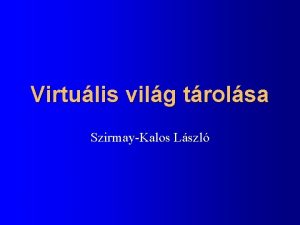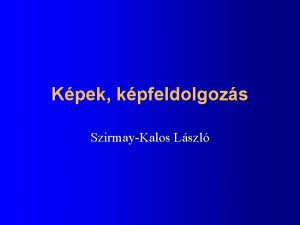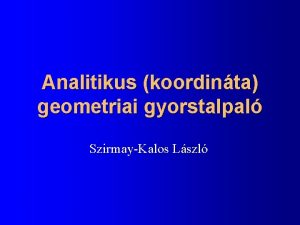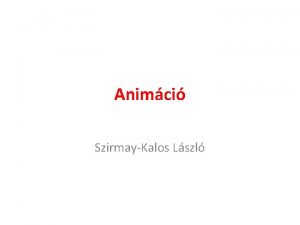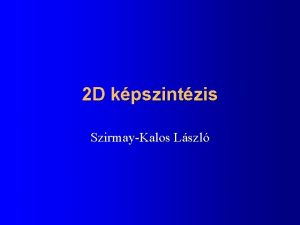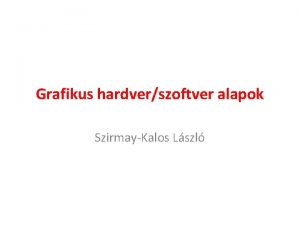2 D rendering SzirmayKalos Lszl 2 D rendering







![Vectorization r(t), t in [0, 1] r 2 r 1 rn [0, 1]: t Vectorization r(t), t in [0, 1] r 2 r 1 rn [0, 1]: t](https://slidetodoc.com/presentation_image/5ef7b139072c47beaddde777c950e47a/image-8.jpg)















![(Ivan) Sutherland-Hodgeman poligon clipping p[2] q[2] p[3] p[4] q[3] Polygon. Clip(p[n] q[m]) p[5] m (Ivan) Sutherland-Hodgeman poligon clipping p[2] q[2] p[3] p[4] q[3] Polygon. Clip(p[n] q[m]) p[5] m](https://slidetodoc.com/presentation_image/5ef7b139072c47beaddde777c950e47a/image-24.jpg)









![2 D Texturing x=ax u+bx v+cx y=ay u+by v+cy [Xh, Yh, h] = [x, 2 D Texturing x=ax u+bx v+cx y=ay u+by v+cy [Xh, Yh, h] = [x,](https://slidetodoc.com/presentation_image/5ef7b139072c47beaddde777c950e47a/image-34.jpg)











- Slides: 45

2 D rendering Szirmay-Kalos László

2 D rendering color Image (200, 200) viewport Camera window Unit=pixel Drawing with own colors World coordinate system

Pixel-driven rendering: Containment test (object, pont) • Implicit curve: c - + r f(r) = |r-c|2 - R 2 • Parametric curve: out in 3 2 1 Infinity is out! boundary > 0 : one side f(x, y) = 0 : boundary < 0 : other side (usually inside)

Pixel-driven rendering struct Object { vec 3 color; virtual bool In(vec 2 r) = 0; // containment test }; struct Circle : public Object { vec 2 center; float R; bool In(vec 2 r) { return (dot(r-center, r-center)–R*R < 0); } }; struct Half. Plane : public Object { vec 2 r 0, n; // position vec, normal vec bool In(vec 2 r) { return (dot(r–r 0, n) < 0); } }; struct General. Ellipse : public Object { vec 2 f 1, f 2; float C; bool In(vec 2 r) { return (length(r-f 1) + length(r-f 2) < C); } }; struct Parabola : public Object { vec 2 f, r 0, n; // f = focus, (r 0, n) = directrix, n is unitvec bool In(vec 2 r) { return (fabs(dot(r-r 0, n)) > length(r–f)); } };

Pixel-driven rendering class Scene { // virtual world list<Object *> objs; // objects with decreasing priority Object *picked = nullptr; // selected for operation public: void Add(Object * o) { objects. push_front(o); picked = o; } void Pick(int p. X, int p. Y) { vec 2 w. Point = Viewport 2 Window(p. X, p. Y); picked = nullptr; for(auto o : objs) if (o->In(w. Point)) { picked = o; return; } } void Bring. To. Front() { if (picked) { objs. erase(find(objs. begin(), objs. end(), picked)); objs. push_front(picked); } } void Render() { for(int p. X=0; p. X<xmax; p. X++) for(int p. Y=0; p. Y<ymax; p. Y++) { vec 2 w. Point = Viewport 2 Window(p. X, p. Y); for(auto o : objs) if (o->In(w. Point)) { image[p. Y][p. X] = o->color; break; } };

Object-driven rendering: 2 D pipeline World Reference state (modeling space) vectorization Modeling transform window Képernyőre vetítés Screen or app. Window (1, 1) Clipping + (-1, -1) viewport rasterization viewport transform Normalized device space viewport Screen space

Object-driven rendering: 2 D pipeline World Reference state (modeling space) CPU program vectorization C++ GPU VAOs Modeling transform GPU Vertex shader GLSLwindow Képernyőre vetítés Screen or app. Window (1, 1) Clipping + (-1, -1) viewport GPU viewport Fixed pipeline transform Normalized device space Screen space GPU Fragrasterization ment Shader GLSL viewport GPU Frame buffer
![Vectorization rt t in 0 1 r 2 r 1 rn 0 1 t Vectorization r(t), t in [0, 1] r 2 r 1 rn [0, 1]: t](https://slidetodoc.com/presentation_image/5ef7b139072c47beaddde777c950e47a/image-8.jpg)
Vectorization r(t), t in [0, 1] r 2 r 1 rn [0, 1]: t 1= 0, t 2 = 1/n , . . . , tn =1 r 1 =r(0), r 2 = r(t 2), … , rn = r(1) Curve Line strip Region boundary line loop = polygon For HW support line segments triangles

Decomposing a polygon to triangles Cutting at a diagonal reduces the number of vertices Convex: O(n) Non-diagonal Concave: O(n 3) diagonal Theorem: Every simple polygon of 4+ vertices has diagonal, i. e. it can be decomposed to triangles via diagonals. Convex vertex

Ear pi-1 diagonal pi+1 pi is ear if pi-1 – pi+1 is diagonal l Ear can be cut! l Ear clipping: Find an ear and cut! l pi Two ears theorem: Every simple polygon of 4+ vertices has at least 2 ears. „Every tree has at least two leaves. ”

Ear clipping: O(n 2) 1 3 2 (x 12, y 12) (x 21, y 21) 43 0 (x 22, y 22) Segment to segment intersection: x 1(t 1)=x 11 t 1+x 12(1 -t 1) y 1(t 1)=y 11 t 1+y 12(1 -t 1), t 1 (0, 1) x 2(t 2)=x 21 t 2+x 22(1 -t 2) y 2(t 2)=y 21 t 2+y 22(1 -t 2), t 2 (0, 1) x 1(t 1)= x 2(t 2) ? t 1, t 2 (0, 1) y (t )= y (t ) 2 2 (x 11, y 11) 1 1

Line segment to line segment intersection

Two points are on the two sides of a line

Modeling transformation (Matrices are computed on the CPU, transformations are executed by the GPU) Sx 0 0 cos f sin f 0 1 0 0 0 Sy 0 -sin f cos f 0 0 1 0 px py 1 [xw , yw , 1] = [xm , ym , 1] 0 0 1 (xw , yw) (xm , ym) j’ i’ o (xw , yw) = o + xm i’ + ym j’

View transformation V(): Center of the camera window to the origin world wx wx (xw , yw) (cx, cy) w y (xv, yv) wy xv = xw-cx yv = yw-cy window 1 0 0 1 0 [xv, yv, 1] = [xw, yw, 1] -cx -cy 1

Projection P(): Camera window to a square of corners (-1, -1) and (1, 1) Normalized device (1, 1) wx (xv, yv) wy (xc, yc) xc = xv * 2/wx yc = yv * 2/wy ablak (-1, -1) 2/wx 0 0 2/wy 0 [xc, yc, 1] = [xv, yv, 1] 0 0 1

2 D camera class Camera 2 D { vec 2 w. Center; // center in world coords vec 2 w. Size; // width and height in world coords public: mat 4 V() { return Translate. Matrix(-w. Center); } mat 4 P() { // projection matrix: return Scale. Matrix(vec 2(2/w. Size. x, 2/w. Size. y)); } mat 4 Vinv() { return Translate. Matrix(w. Center); } mat 4 Pinv() { // inverse projection matrix return Scale. Matrix(vec 2(w. Size. x/2, w. Size. y/2)); } void Zoom(float s) { w. Size = w. Size * s; } void Pan(vec 2 t) { w. Center = w. Center + t; } };

Point clipping: Clipping (GPU) x > xmin= -1 x < xmax= +1 y > ymin= -1 ymax (x, y) xmax Inside xmin Outside ymin y < ymax= +1

Clipping x > xmin (x, y) Outside Inside

Clipping y > ymin Inside (x, y) ymin Outside

Clipping x < xmax (x, y) Inside Outside

Clipping y < ymax Outside Inside (x, y)

x 1, y 1 Line segment clipping: x < xmax x 2, y 2 x 1, y 1 xmax x i, y i x 2, y 2 x(t) = x 1 + (x 2 - x 1)t, y(t) = y 1 + (y 2 - y 1)t x = xmax Intersection: xmax= x 1 + (x 2 - x 1)t t = (xmax-x 1)/(x 2 -x 1) xi = xmax yi = y 1 + (y 2 - y 1) (xmax-x 1)/(x 2 -x 1)
![Ivan SutherlandHodgeman poligon clipping p2 q2 p3 p4 q3 Polygon Clippn qm p5 m (Ivan) Sutherland-Hodgeman poligon clipping p[2] q[2] p[3] p[4] q[3] Polygon. Clip(p[n] q[m]) p[5] m](https://slidetodoc.com/presentation_image/5ef7b139072c47beaddde777c950e47a/image-24.jpg)
(Ivan) Sutherland-Hodgeman poligon clipping p[2] q[2] p[3] p[4] q[3] Polygon. Clip(p[n] q[m]) p[5] m = 0; for(i=0; i < n; i++) { p[1] q[4] p[0] if (p[i] inside) { q[1] q[0] q[m++] = p[i]; if (p[i+1] outside) q[m++] = Intersect(p[i], p[i+1], boundary); } else { if (p[i+1] inside) q[m++] = Intersect(p[i], p[i+1], boundary); } } Insert the first point at } the end as well.

Clipping in homogeneous coordinates Cél: -1 < X = Xh/h < 1 -1 < Y = Yh/h < 1 -1 < Z = Zh/h < 1 h > 0 h < 0 -h < Xh < h -h < Yh < h -h < Zh < h -h > Xh > h -h > Yh > h -h > Zh > h h = Xh Out [3, 0, 0, 2 ] h = 2 < Xh = 3 In [2, 0, 0, 3 ] h = 3 > Xh = 2

Line segment clipping in homogeneous coordinates -h < Xh < h -h < Yh < h -h < Zh < h h = Xh [Xh 1, Yh 1, Zh 1, h 1] h = h 1·(1 -t)+h 2 ·t = = Xh 1·(1 -t) + Xh 2·t t = … [Xh 2, Yh 2, Zh 2, h 2] Xh = Xh 1 · (1 -t) + Xh 2 · t Yh = Yh 1 · (1 -t) + Yh 2 · t Zh = Zh 1 · (1 -t) + Zh 2 · t h = h 1 · (1 -t) + h 2 · t

Viewport transformation: From normalized device space to screen space Normalized device (1, 1) (xc, yc) (-1, -1) Screen vw X = vw(xc +1)/2+vx Y = vh(yc +1)/2+vy Z = (zc +1)/2 vh (X, Y) (vx, vy) viewport Unit=pixel gl. Viewport(vx, vy, vw, vh);

Rasterization (GPU) model 2 -3 vertices / primitive MVP transformation clipping 4 muls + 4 adds 4 comps rasterization Pixels Primitives viewport transformation 2 muls + 2 adds Pixel ops Many (!) pixels nanosec/pixel Frame buffer

Line segment rasterization Explicit equation of the line: y = mx + b Drawing algorithm: x 1 x 2 for( x = x 1; x <= x 2; x++ ) { Y = m*x + b; y = Round( Y ); write( x, y ); }

Incremental principle and fixed point implementation Y(x)=mx+b =Y(x-1)+m Line. Float (short x 1, short y 1, short x 2, short y 2) { float m = (y 2 - y 1)/(x 2 - x 1); float Y = y 1; for(short x = x 1; x <= x 2; x++) { short y = round(Y); write(x, y, color); Y = Y+m; } } Babbage’s Difference Engine const int T=12; Line. Fix (short x 1, short y 1, short x 2, short y 2) { int m = ((y 2 - y 1)<<T)/(x 2 - x 1); int Y = (y 1<<T) + (1<<(T-1)); for(short x = x 1; x <= x 2; x++) { short y = Y>>T; write(x, y, color); Y = Y+m; } }

DDA line rasterization hardware y x X counter Y register 10… CLK x 1 S y 1 m

Triangle fill (X 3, Y 3) y = mx + b 1/m (X 2, Y 2) y x(y) (X 1, Y 1) x(y+2) x(y+1) = x(y)+1/m

Pixel color? • Uniform • Calculating from interpolated vertex properties • Texturing (2 D): Interpolation of vertex texture coordinates + texture fetch.
![2 D Texturing xax ubx vcx yay uby vcy Xh Yh h x 2 D Texturing x=ax u+bx v+cx y=ay u+by v+cy [Xh, Yh, h] = [x,](https://slidetodoc.com/presentation_image/5ef7b139072c47beaddde777c950e47a/image-34.jpg)
2 D Texturing x=ax u+bx v+cx y=ay u+by v+cy [Xh, Yh, h] = [x, y, 1]T (X, Y)= [Xh/h, Yh/h] Parameterization Rendering v 1 (x 1, y 1) (u 1, v 1) (u 3, v 3) (u 2, v 2) y u Texture space: Unit square 1 Y (X 1, Y 1), h 1 (u 1, v 1) (x 2, y 2) (x 3, y 3) x (X 3, Y 3), h 3 (u 3, v 3) Model [X h, Y h, h] = [u, v, 1] T, [U, V, H] = [u/h, v/h, 1/h] = [X, Y, 1] T-1 u = U/H, v = V/H (X 2, Y 2), h 2 (u 2, v 2) X Image

Linear interpolation u (X 2, Y 2, U 2) U(X, Y) = Au X+Bu. Y+Cu Y (X 1, Y 1, U 1) (X 3, Y 3, U 3) U(X, Y) X U(X+1, Y) = U(X, Y) + Au Screen

Interpolation hardware X X counter H=1/h register v(X, Y) Div U=u/h register V=v/h register S S Ah u(X, Y) Au S Av

Triangle setup u (X 2, Y 2, U 2) U 1= AX 1+BY 1+C U 2= AX 2+BY 2+C U 3= AX 3+BY 3+C n nx Y (X 1, Y 1, U 1) (X 3, Y 3, U 3) X U(X, Y) = AX+BY+C nx. X+ny. Y+nu. U+d = 0 (U 3 -U 1)(Y 2 -Y 1) - (Y 3 -Y 1)(U 2 -U 1) A= (X 3 -X 1)(Y 2 -Y 1) - (Y 3 -Y 1)(X 2 -X 1) i j X 2 -X 1 Y 2 -Y 1 n = (X 2 -X 1, Y 2 -Y 1, U 2 -U 1) (X 3 -X 1, Y 3 -Y 1, U 3 -U 1) = X 3 -X 1 Y 3 -Y 1 -nu k U 2 -U 1 U 3 -U 1

Texture filtering (GL_NEAREST) Magnification Minification u(X, Y) v Y u X Texture space Image space

Texture space and Image space correspondence Magnification Minification gl. Tex. Parameteri(GL_TEXTURE_2 D, GL_TEXTURE_MAG_FILTER, GL_NEAREST); gl. Tex. Parameteri(GL_TEXTURE_2 D, GL_TEXTURE_MIN_FILTER, GL_NEAREST);

Mip-map (multum in parvo) Good for Minification Y X a) gl. Tex. Parameteri(GL_TEXTURE_2 D, GL_TEXTURE_MIN_FILTER, GL_LINEAR_MIPMAP_NEAREST); // Mip-mapping, b) gl. Tex. Parameteri(GL_TEXTURE_2 D, GL_TEXTURE_MIN_FILTER, GL_LINEAR_MIPMAP_LINEAR); // Tri-linear filtering

Mip-map GL_NEAREST GL_LINEAR_MIPMAP_NEAREST

Bi-linear texture filtering Good for Magnification gl. Tex. Parameteri(GL_TEXTURE_2 D, GL_TEXTURE_MIN_FILTER, GL_LINEAR); gl. Tex. Parameteri(GL_TEXTURE_2 D, GL_TEXTURE_MAG_FILTER, GL_LINEAR);

Bi-linear filtering GL_NEAREST GL_LINEAR

Blending: Order matters! gl. Enable(GL_BLEND); gl. Blend. Func( GL_SRC_ALPHA, GL_ONE_MINUS_SRC_ALPHA ); New color (Rs, Gs, Bs, As) gl. Draw. Arrays(GL_TRIANGLES, 0, n. Vtx); gl. Disable(GL_BLEND); (Rd, Gd, Bd, Ad) * * ALU (R, G, B, A) Frame buffer (R, G, B, A) = (Rs. As+Rd(1 -As), Gs. As+Gd (1 -As), Bs. As+Bd (1 -As), As. As+Ad (1 -As))

Excercises • Prove that any polygon of at least 4 vertices has a diagonal! • Prove the two ears theorem! • Does it make sense to develop a circle rasterization algorithm? • Write a polygon filling algorithm that can handle even non -simple polygons (the boundary can be built of multiple polylines and may intersect itself). • Implement the learnt clipping and rasterization algorithms! • Write a program that decides whether an axis aligned window may contain any primitive. • Give the class diagram of a Power. Point like program. • What is the rational behind the introduction of normalized device space?
 Graph limit theory
Graph limit theory Lszl charts
Lszl charts Real time rendering architecture
Real time rendering architecture Computer graphics pipeline
Computer graphics pipeline Inverse rendering
Inverse rendering Hair rendering
Hair rendering Rendering fur with three dimensional textures
Rendering fur with three dimensional textures Teknik rendering grafik tiga dimensi dengan interaksi sinar
Teknik rendering grafik tiga dimensi dengan interaksi sinar Game rendering techniques
Game rendering techniques Photorealistic rendering carlsbad
Photorealistic rendering carlsbad Surfels: surface elements as rendering primitives
Surfels: surface elements as rendering primitives Renderer
Renderer Eurographics symposium on rendering
Eurographics symposium on rendering Advances in real time rendering
Advances in real time rendering Rendering equation
Rendering equation Introduction to volume rendering
Introduction to volume rendering Jerry tessendorf
Jerry tessendorf Radiosity rendering
Radiosity rendering Graphics rendering
Graphics rendering Guillaume fenelon
Guillaume fenelon Indirect volume rendering
Indirect volume rendering Clustered forward rendering
Clustered forward rendering Rastorization
Rastorization Camera translate
Camera translate Solid edge rendering
Solid edge rendering Radiosity rendering
Radiosity rendering David rosen sega
David rosen sega Visual rendering
Visual rendering Christopher buehler
Christopher buehler Image-based modeling and rendering
Image-based modeling and rendering Kajiya rendering equation
Kajiya rendering equation Graphics rendering
Graphics rendering Raycasting dda
Raycasting dda Shadow rendering techniques
Shadow rendering techniques Car paint rendering
Car paint rendering Beauty pass render
Beauty pass render Masaki kawase
Masaki kawase Multipass rendering
Multipass rendering Rendering
Rendering Rendering realtime compositing
Rendering realtime compositing Kajiya rendering equation
Kajiya rendering equation Reyes rendering
Reyes rendering Berlatih teknik arsir gradasi
Berlatih teknik arsir gradasi Lumigraph rendering
Lumigraph rendering Maya rendering with aneka
Maya rendering with aneka Rendering of carcass
Rendering of carcass
